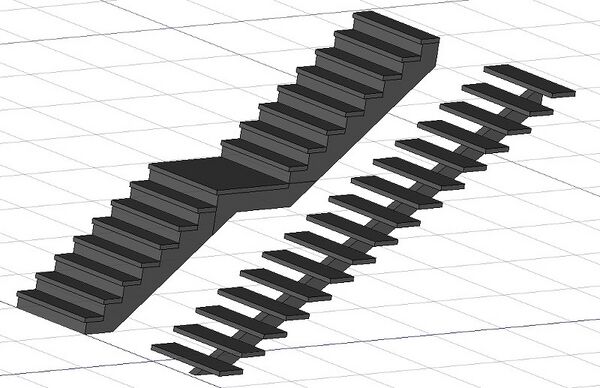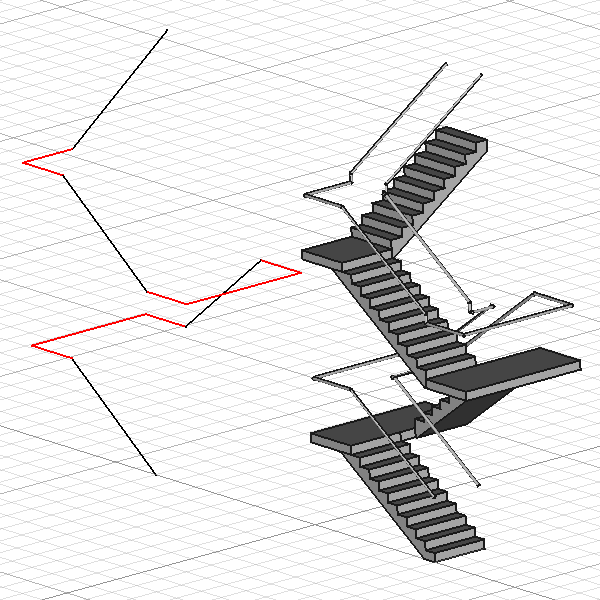Arch Stairs/pl: Difference between revisions
(Updating to match new version of source page) |
(Updating to match new version of source page) |
||
| Line 21: | Line 21: | ||
==Description== |
==Description== |
||
The [[Arch_Stairs|Arch Stairs]] tool allows you to build |
The [[Arch_Stairs|Arch Stairs]] tool allows you to build several types of stairs automatically. Straight stairs (with or without a central landing) can be created from scratch. More complex stairs require base objects. |
||
See the [https://en.wikipedia.org/wiki/Stairs Stairs entry in wikipedia] for a definition of the different terms used to describe parts of stairs. |
See the [https://en.wikipedia.org/wiki/Stairs Stairs entry in wikipedia] for a definition of the different terms used to describe parts of stairs. |
||
[[Image: |
[[Image:Arch_Stairs_example.jpg|600px]] |
||
{{Caption|Two constructed stairs, one with a massive structure and a landing, |
{{Caption|Two constructed stairs, one with a massive structure and a landing, the other with a single stringer.}} |
||
==Options== |
==Options== |
||
| Line 34: | Line 34: | ||
==Usage== |
==Usage== |
||
# Optionally select one or more base objects, for example [[Draft_Line|Draft Lines]] and [[Draft_Wire|Draft Wires]]: |
|||
#* Draft Wires with two or more segments will be used to create landings. They must be on a plane parallel to the global XY plane. For example, select a U-shaped wire for a half-turn landing and an L-shaped wire for a corner landing. |
|||
#* Draft Lines will be used to create flights. |
|||
#* If the vertices of all lines and wires have correct Z coordinates, the created stairs will use this information. |
|||
#* The base objects must be selected in the correct order starting with the bottom object. |
|||
# Press the {{Button|[[Image:Arch_Stairs.svg|16px]] [[Arch_Stairs|Arch Stairs]]}} button, or press {{KEY|S}}, {{KEY|R}} keys. |
# Press the {{Button|[[Image:Arch_Stairs.svg|16px]] [[Arch_Stairs|Arch Stairs]]}} button, or press {{KEY|S}}, {{KEY|R}} keys. |
||
# Adjust the desired properties. Some parts of the stairs, such as the structure, might not appear immediately, if any of the properties makes it impossible, such as a structure thickness of 0. |
# Adjust the desired properties. Some parts of the stairs, such as the structure, might not appear immediately, if any of the properties makes it impossible, such as a structure thickness of 0. |
||
[[Image:Arch_Stairs_Complex_Example.png|600px]] |
|||
{{Caption|Complex stairs based on a selection of lines and wired as shown on the left.<br> |
|||
In red the wires used for the landings at Z=1500mm, Z=3000mm and Z=4500mm.<br> |
|||
In black the lines connecting them used for the flights. |
|||
}} |
|||
==Properties== |
==Properties== |
||
| Line 69: | Line 80: | ||
* {{PropertyData|Landing Depth|Length}}: The depth of the landing of the flight, if enabled in {{PropertyData|Landings}}. Defaults to the {{PropertyData|Width}} if 0. |
* {{PropertyData|Landing Depth|Length}}: The depth of the landing of the flight, if enabled in {{PropertyData|Landings}}. Defaults to the {{PropertyData|Width}} if 0. |
||
* {{PropertyData|Nosing|Length}}: The size of the nosing. |
* {{PropertyData|Nosing|Length}}: The size of the nosing. |
||
* {{PropertyData|Number Of Steps|Integer}}: The numbers of steps (risers). |
* {{PropertyData|Number Of Steps|Integer}}: The numbers of steps (risers). Must be at least 2 for a single flight, and at least 4 for a stairs with a central landing. |
||
* {{PropertyData|Riser Height|Length}}: (read-only) The height of the risers. If {{PropertyData|Riser Height Enforce}} is 0 it is calculated ({{PropertyData|Height}} / {{PropertyData|Number of Steps}}). Else it is the same as {{PropertyData|Riser Height Enforce}}. |
* {{PropertyData|Riser Height|Length}}: (read-only) The height of the risers. If {{PropertyData|Riser Height Enforce}} is 0 it is calculated ({{PropertyData|Height}} / {{PropertyData|Number of Steps}}). Else it is the same as {{PropertyData|Riser Height Enforce}}. |
||
* {{PropertyData|Riser Height Enforce|Length}}: The enforced height of the risers. |
* {{PropertyData|Riser Height Enforce|Length}}: The enforced height of the risers. |
||
Revision as of 17:50, 23 February 2023
|
|
| Menu location |
|---|
| Arch → Stairs |
| Workbenches |
| Arch |
| Default shortcut |
| S R |
| Introduced in version |
| 0.14 |
| See also |
| Arch Structure, Arch Equipment |
Description
The Arch Stairs tool allows you to build several types of stairs automatically. Straight stairs (with or without a central landing) can be created from scratch. More complex stairs require base objects.
See the Stairs entry in wikipedia for a definition of the different terms used to describe parts of stairs.
Two constructed stairs, one with a massive structure and a landing, the other with a single stringer.
Options
- Stairs share the common properties and behaviors of all Arch Components
Usage
- Optionally select one or more base objects, for example Draft Lines and Draft Wires:
- Draft Wires with two or more segments will be used to create landings. They must be on a plane parallel to the global XY plane. For example, select a U-shaped wire for a half-turn landing and an L-shaped wire for a corner landing.
- Draft Lines will be used to create flights.
- If the vertices of all lines and wires have correct Z coordinates, the created stairs will use this information.
- The base objects must be selected in the correct order starting with the bottom object.
- Press the
Arch Stairs button, or press S, R keys.
- Adjust the desired properties. Some parts of the stairs, such as the structure, might not appear immediately, if any of the properties makes it impossible, such as a structure thickness of 0.
Complex stairs based on a selection of lines and wired as shown on the left.
In red the wires used for the landings at Z=1500mm, Z=3000mm and Z=4500mm.
In black the lines connecting them used for the flights.
Properties
Data
Segment and Parts
- DANEAbs Top (
Vector): (read-only) The absolute top level the stairs lead to. - DANELast Segment (
Link): Last segment (flight or landing) of an Arch Stairs connecting to this segment. The start level of the stairs will be the end level of this last segment. - DANEOutline Left (
VectorList): The left outline of the stairs. - DANEOutline Left All (
VectorList): The left outline of all segments of the stairs. - DANEOutline Right (
VectorList): The right outline of the stairs. - DANEOutline Right All (
VectorList): The right outline of all segments of the stairs. - DANERailing Height Left (
Length): Height of the left railing of the stairs or landing. - DANERailing Height Right (
Length): Height of the right railing of the stairs or landing. - DANERailing Left (
LinkHidden): The left railing object. introduced in version 0.20: Property type updated fromStringtoLinkHidden. - DANERailing Offset Left (
Length): Offset of the left railing from the edge of the stairs or landing. - DANERailing Offset Right (
Length): Offset of the right railing from the edge of the stairs or landing. - DANERailing Right (
LinkHidden): The right railing object. introduced in version 0.20: Property type updated fromStringtoLinkHidden.
Stairs
- DANEAlign (
Enumeration): The alignment of the stairs on the baseline. Only used if a baseline is defined. Can beLeft,RightorCenter. - DANEHeight (
Length): The total height of the stairs. Only used if no baseline is defined, or if the baseline is horizontal. Ignored if DANERiser Height Enforce is non-zero. - DANELength (
Length): The total length of the stairs if no baseline is defined. Ignored if DANETread Depth Enforce is non-zero. - DANEWidth (
Length): The width of the stairs. - DANEWidth of Landing (
FloatList): If the DANENumber Of Steps is 1, the stairs object acts as a landing. When this is the case and the baseline is multi-segment, the width of first segment of the landing follows the DANEWidth, the widths of subsequent segments follow the list set here.
Steps
- DANEBlondel Ratio (
Float): (read-only) The calculated Blondel ratio. This ratio indicates comfortable stairs and should be between 62 and 64cm or 24.5 and 25.5in. - DANELanding Depth (
Length): The depth of the landing of the flight, if enabled in DANELandings. Defaults to the DANEWidth if 0. - DANENosing (
Length): The size of the nosing. - DANENumber Of Steps (
Integer): The numbers of steps (risers). Must be at least 2 for a single flight, and at least 4 for a stairs with a central landing. - DANERiser Height (
Length): (read-only) The height of the risers. If DANERiser Height Enforce is 0 it is calculated (DANEHeight / DANENumber of Steps). Else it is the same as DANERiser Height Enforce. - DANERiser Height Enforce (
Length): The enforced height of the risers. - DANERiser Thickness (
Length): The thickness of the risers. - DANETread Depth (
Length): (read-only) The depth of the treads. If DANETread Depth Enforce is 0 it is calculated (DANELength / DANENumber of Steps). Else it is the same as DANETread Depth Enforce. - DANETread Depth Enforce (
Length): The enforced depth of the treads. - DANETread Thickness (
Length): The thickness of the treads.
Structure
- DANEConnection Down Start Stairs (
Enumeration): The type of connection between the lower floor slab and the start of the stairs. Can beHorizontalCut,VerticalCutorHorizontalVerticalCut. - DANEConnection End Stairs Up (
Enumeration): The type of connection between the end of the stairs and the upper floor slab. Can betoFlightThicknessortoSlabThickness. - DANEDown Slab Thickness (
Length): The thickness of the lower floor slab. - DANEFlight (
Enumeration): The direction of the flight after the landing. Can beStraight,HalfTurnLeftorHalfTurnRight. - DANELandings (
Enumeration): The type of landings. Can beNoneorAt center(At each cornernot implemented yet). - DANEStringer Overlap (
Length): The overlap of the stringers above the bottom of the treads. - DANEStringer Width (
Length): The width of the stringers. - DANEStructure (
Enumeration): The structure type of the stairs. Can beNone,Massive,One stringerorTwo stringers. - DANEStructure Offset (
Length): The offset between the border of the stairs and the structure. - DANEStructure Thickness (
Length): The thickness of the structure. - DANEUp Slab Thickness (
Length): The thickness of the upper floor slab. - DANEWinders (
Enumeration): The type of winders. Not implemented.
Limitations
- Only straight stairs are available at the moment
- See the forum entry for circle stairs.
- See the forum announcement.
Scripting
See also: Arch API and FreeCAD Scripting Basics.
The Stairs tool can be used in macros and from the Python console by using the following function:
Stairs = makeStairs(baseobj=None, length=None, width=None, height=None, steps=None, name="Stairs")
- Creates a
Stairsobject from the givenbaseobj. - If
baseobjis not given, it will uselength,width,height, andsteps, to build a solid object.
Example:
import Arch
Stairs = Arch.makeStairs(length=5000, width=1200, height=3000, steps=14)
- Elementy: Mury, Konstrukcja, ściana kurtynowa, Okna, Drzwi, Dach, Kubatura, Schody, Wyposażenie, Ramy, Ogrodzenie, Kratownica, Profil, Rura, Kształtka
- Zbrojenie: Pręty zbrojeniowe proste, Pręty zbrojeniowe typu U, Pręty zbrojeniowe typu L, Strzemiona, Strzemiona, Pręty zbrojeniowe spiralne, Zbrojenie słupów, Zbrojenie belek, Zbrojenie płyt stropowych, Zbrojenie stóp fundamentowych, Pręt zbrojeniowy
- Panels: Panel, Panelizacja do cięcia, Arkusz panela, Zagnieżdżanie
- Materiał: Wybór materiału, Materiał złożony
- Organizacja: Część budowli, Projekt, Teren, Budowla, Piętro, Odniesienie, Płaszczyzna przekroju, Obmiar
- Osie: Osie, Układ osi, Siatka
- Modifikacja: Płaszczyzna cięcia, Komponent dodaj, Komponent usuń, Przegląd
- Narzędzia: Komponent, Klonuj komponent, Podziel siatkę, Siatka na kształt, Zaznacz siatki nie bryłowe, Usuń kształt., Zamknij otwory, Połącz ściany, Sprawdź, Przełącz flagę Brep IFC, Trzy widoki, Arkusz kalkulacyjny IFC, Przełącz widoczność odjęcia
- Dodatkowe: Preferencje, Ustawienia Importu i Eksportu (IFC, DAE, OBJ, JSON, 3DS); SHP), Architektura: API
- Jak zacząć
- Instalacja: Pobieranie programu, Windows, Linux, Mac, Dodatkowych komponentów, Docker, AppImage, Ubuntu Snap
- Podstawy: Informacje na temat FreeCAD, Interfejs użytkownika, Profil nawigacji myszką, Metody wyboru, Nazwa obiektu, Edytor ustawień, Środowiska pracy, Struktura dokumentu, Właściwości, Pomóż w rozwoju FreeCAD, Dotacje
- Pomoc: Poradniki, Wideo poradniki
- Środowiska pracy: Strona Startowa, Architektura, Assembly, CAM, Rysunek Roboczy, MES, Inspekcja, Siatka, OpenSCAD, Część, Projekt Części, Punkty, Inżynieria Wsteczna, Robot, Szkicownik, Arkusz Kalkulacyjny, Powierzchnia 3D, Rysunek Techniczny, Test Framework

